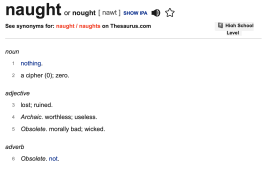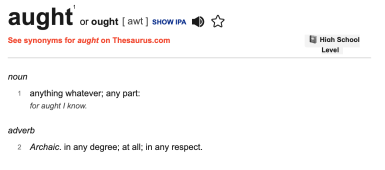wattmatters
Solar Wizard
Interesting.naught = never, nothing; pronoun
“with naught a concern” pre-modern pre-colonial english; 1200-1400ad
aught = zero; a digit; noun. Or: indiscriminate slight value above zero not defined by a fraction or whole number; “two aught cable” “double aught buckshot;” “seven aught miles from town, third farm on the left.” Colonial to modern english.
If I look up US based dictionaries (see below) there is no mention of aught/ought being representative of zero, but it is a definition for naught/nought.
I'm not by any measure saying use of "aught" is wrong, as language is a fluid dynamic thing, it's just one of those strange things you notice and sounds weird to my Aussie ears.
We also often say "oh" when we mean zero. Particularly common when giving a phone number with a zero in it, or say referring to this thread as being "Electrical Acronyms one oh one".




Definition of aught | Dictionary.com
Aught definition, anything whatever; any part: for aught I know. See more.
Websters is the same:


The Oxford English and the Australian Macquarie dictionaries don't seem to have a free to access option, so couldn't post their listings.






